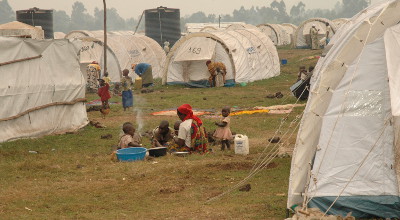World Vision Issues Staunch Request to DRC Government
The Christian organization World Vision has petitioned that the government of the Democratic Republic of Congo to immediately release a large number of children who have been forcibly recruited into armed groups in the eastern part of the country.
Despite the release of an estimated 30,000 child soldiers since the height of armed conflict in eastern DRC, World Vision says there are thousands of children have taken to hiding in the bush to avoid being physically coerced into joining these armed groups.
A high concentration of DRC refugees in Uganda are under the age of 15, and reports suggest that they left the DRC out of fear.
“Children are hiding in the forest in North Kivu, and we know for certain that nearly two hundred children have been kidnapped by armed groups recently and forced to join in the fighting,” said World Vision’s Dominic Keyzer in Goma. “Because of the difficult nature of collecting figures, we’re worried the number of children being lost to the fighting is much higher.”
The situation is a similar one in Rwanda.
“Our main concern is the increasing number of children; 65 percent of the refugees are children and some are unaccompanied,” World Vision’s Martin Tindiwensi said.
Keyzer said the ongoing conflict and insecurity are making it nearly impossible for humanitarian organizations to intervene in the situation. The fighting has forced World Vision to suspend major, life-saving programs in some areas of eastern DRC, and launch responses in both Uganda and Rwanda.
“The effects of this are just heartbreaking—many children in eastern DRC have lived with violence and uncertainty for the last 20 years,” Keyzer said. “Although they have built up good coping mechanisms, constant displacement exposes them to further risks.”
Forced recruitment into armed groups is only one of many of the risks children are facing as a result of the conflict. Little or no access to clean water, food, health services, let alone schooling or safe places, will exacerbate poverty and child deaths in DRC, Keyzer said.
“The most critical programs we have had to shut down include emergency water and sanitation projects responding to outbreaks of cholera near Rutshuru,” he said. “The fighting is putting this on hold, and threatening the gains that have been made in eastern DRC over the past few years.”
Water and sanitation specialist Jonas Habimana reached Goma late last week after evacuating out of Rutshuru.
“When I was forced to leave, the situation was very desperate,” Habimana said. “People were afraid, they were running, and now we’re receiving reports from our local partners still in Rutshuru that youth are being kidnapped by armed groups.”
Building a lasting peace for children caught up in the conflict might be difficult, but Kezyer said it needs to be a priority for everyone involved.
“The UN stabilization force is overwhelmed, governments remain pre-occupied with the political context of the conflict, but we need guaranteed safe corridors to be able to reach women and children caught up in it,” he said. “The conflict affects our ability to do our job, every day.”
World Vision fields staff over the border in Kisoro District, Uganda, where more than 30,000 people are seeking refuge. In northern Rwanda, where nearly 20,000 are gathered, there are reports of suffering of children and women as basic service systems struggle to cope.
“It’s an incredibly sad thing to see,” said World Vision’s Sylvia Nabanoba in Uganda. “There are lots of sick kids in the camp who can’t reach the health center because it’s too far—the camp spans over 18 kilometers. I saw a malnourished boy last week who I’m worried will die if he does not get attention. His mother was holding back tears as she spoke to me.
“Pregnant women are writhing in pain on a mattress on the floor because there are no beds in the health center. It makes you feel incredibly angry with those continuing to cause this conflict. No child should be subjected to this.”
Keyzer challenged the Ugandan, Rwandan and DRC government to protect the children and their families.
“We have seen the difference that can be made when peace gets a chance,” he said. “Despite the complexity of the fighting, the majority of people are yearning to live in peace after nearly 20 years of upheaval. That message needs to be heard by the few who continue to fight.”
Click here for the original article at World Vision.














































